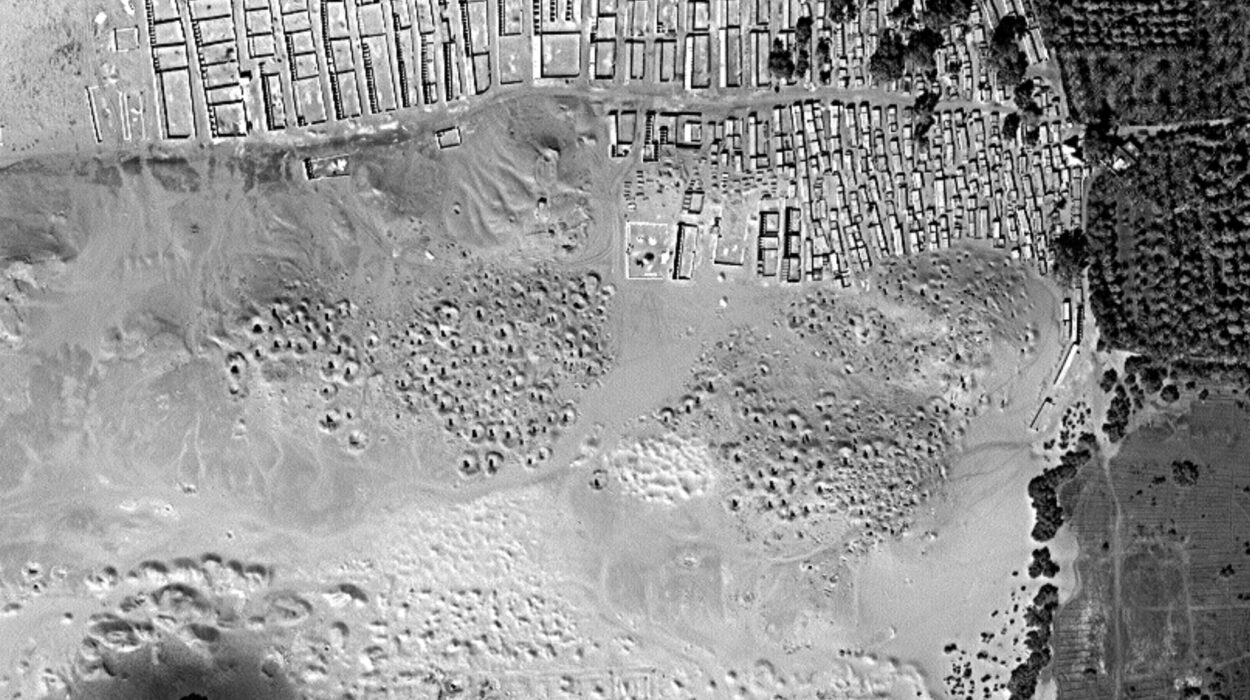In the vast expanse of the Pacific Ocean, scattered across thousands of miles of turquoise water, lie the islands of Micronesia. Among them rests the island of Pohnpei, lush, humid, and green, its mountains veiled in mist and its coasts dotted with mangroves. But beyond the emerald forests and rolling waves stands something that defies easy explanation: the ruins of Nan Madol.
Called the “Venice of the Pacific,” Nan Madol is an ancient city built atop a lagoon, a sprawling network of over ninety artificial islets separated by tidal canals. Towering basalt walls rise from the shallow water, stacked with uncanny precision, forming platforms, temples, and tombs. It is a place that seems almost impossible, a city conjured from stone and sea, a marvel that has haunted explorers, archaeologists, and storytellers for centuries.
The ruins are silent now, their builders long gone, their purpose shrouded in mystery. To walk among Nan Madol’s walls is to feel both awe and unease, as if stepping into a chapter of history humanity forgot how to write. The stones seem too massive to have been moved by ancient hands, the design too elaborate for a culture without wheels, pulleys, or metal tools. And yet, here it stands—a monument to human ingenuity, or perhaps something more.
The Setting: Pohnpei’s Hidden Jewel
Nan Madol is located off the southeastern shore of Pohnpei, a volcanic island blanketed in dense rainforest and crowned with mountains. The island itself is breathtaking, drenched in rainfall that feeds rivers and cascades into waterfalls. It is a land where the natural world thrives with intensity, and within it lies a ruin that feels as though it was carved from myth.
The city stretches across a coral reef, covering approximately 200 acres. Its layout is astonishingly organized: islets are arranged in neat rows, connected by canals that allowed canoes to pass between them. Some islands were designated for dwellings, others for ceremonial purposes, and some for burial sites. The largest structures, including the royal mortuary known as Nandauwas, are constructed with walls up to 25 feet high and 17 feet thick.
To stand at Nandauwas is to confront a paradox. The basalt columns that form its walls are massive—some weighing as much as fifty tons. They are prismatic stones, naturally forming hexagonal shapes, quarried from elsewhere on the island and somehow transported across several miles. How these colossal stones were moved and arranged remains one of the central mysteries of Nan Madol.
Legends of Origins
For the people of Pohnpei, Nan Madol is not merely an archaeological site; it is woven into the mythology of their ancestors. According to legend, the city was built by two brothers, Olisihpa and Olosohpa, who came from a distant land in search of a place to honor their gods. Gifted with magical powers, they summoned a dragon to help them lift and place the great stones. The brothers established the Saudeleur Dynasty, which would rule Pohnpei for centuries.
These legends, though cloaked in myth, contain echoes of history. The Saudeleur rulers, according to oral tradition, were foreign in origin and governed with an iron hand, demanding tribute and centralizing power. Their reign, which began around the 12th century and lasted until the late 17th century, left a deep imprint on the island’s culture. Nan Madol, with its formidable walls and ritual spaces, was their seat of power.
But the legends also remind us of something deeper: that for the people of Micronesia, Nan Madol is a sacred place, both feared and revered. Even today, locals speak of the ruins in hushed tones, suggesting that spirits guard the site, and that disturbing it invites misfortune.
Engineering Feats Beyond Explanation
When archaeologists first studied Nan Madol in the late 19th and early 20th centuries, they were struck by the scale of its construction. Without advanced tools or machinery, how did the builders move and position thousands of basalt columns, some over twenty feet long?
The stones were quarried from distant locations, likely from volcanic outcrops several miles away. Transporting them would have required immense coordination, manpower, and ingenuity. Some theories suggest that the stones were floated on rafts, while others propose that they were rolled on palm logs. Yet the sheer size of many blocks raises doubts about the practicality of such methods.
Adding to the mystery is the precision with which the stones are stacked. The walls are built in a crisscross pattern resembling a log cabin, interlocking the basalt prisms to create stability. Despite centuries of exposure to tides, storms, and earthquakes, the structures remain standing, a testament to the builders’ knowledge of engineering and design.
The canals, too, reflect careful planning. They were not simply dug randomly but appear to have been integrated into the city’s design, functioning as transportation routes and boundaries between districts. Nan Madol was not just a fortress; it was a functioning urban center, meticulously organized in an environment where such a city should have been impossible.
A Seat of Power and Ceremony
Nan Madol was not built as a typical settlement. Archaeological evidence suggests it was more ceremonial and political than residential. While a small elite may have lived within its walls, the majority of Pohnpei’s population lived on the main island.
The city appears to have functioned as a religious and administrative hub. Nandauwas, the royal mortuary, housed the tombs of the Saudeleur rulers. Other islets contained platforms for rituals, areas for priests, and storage for food and goods collected as tribute. The canals may have symbolized separation between sacred and mundane spaces, reinforcing the rulers’ authority.
The choice to build Nan Madol on water may have been symbolic as well as practical. Isolated by the sea, the rulers could separate themselves from the population, creating an aura of divine power. The city itself, rising from the waves, may have embodied a cosmological vision of the world—an intersection of land, sea, and spirit.
Decline and Abandonment
The Saudeleur Dynasty’s reign eventually collapsed in the late 17th century. According to tradition, their rule became increasingly oppressive, demanding excessive tribute and losing the support of the people. A warrior named Isokelekel, said to have descended from the gods, led a revolt that toppled the dynasty. Afterward, Nan Madol was gradually abandoned.
Why the city was not maintained remains a mystery. Perhaps it was simply too difficult to sustain such a monumental site in the lagoon. Perhaps the symbolic power of the city faded with the fall of its rulers. Or perhaps, as local traditions suggest, people feared the site, believing it to be haunted by spirits of the past.
By the time European explorers arrived in the 16th and 17th centuries, Nan Madol was already in ruins, overgrown and silent. The city became an enigma to outsiders, its origins obscured by time and myth.
Archaeological Insights
Modern archaeology has provided valuable, though incomplete, insights into Nan Madol. Radiocarbon dating suggests construction began around the 12th century and continued for several centuries. Excavations have revealed artifacts such as pottery, tools, and beads, offering glimpses into the daily life and rituals that once animated the city.
Yet much remains unknown. No written records survive from the builders of Nan Madol, and oral traditions, though rich, are layered with myth. The logistics of the city’s construction, the exact function of many structures, and the reasons for its abandonment are still debated.
Archaeologists continue to study the site, using modern techniques such as ground-penetrating radar and aerial mapping to uncover hidden structures. But for all that science reveals, Nan Madol resists simple explanations, holding onto its secrets with stubborn silence.
A World Heritage Mystery
In 2016, Nan Madol was declared a UNESCO World Heritage Site, recognized for its cultural significance and its mysterious grandeur. It stands alongside the great ruins of the world—Machu Picchu, Angkor Wat, Stonehenge—as a testament to humanity’s drive to build monuments that transcend time.
Yet Nan Madol remains less known than many of its counterparts, hidden away in the Pacific, visited by few. This obscurity adds to its allure. Unlike the bustling tourist centers of other ruins, Nan Madol feels untouched, a place where the past lingers in the air, where silence deepens the sense of mystery.
Theories and Speculations
Because so much about Nan Madol remains unexplained, it has inspired a wealth of theories, some scientific, others more speculative.
Archaeologists emphasize the ingenuity of the islanders, arguing that with enough manpower and organization, the construction was possible using traditional methods. They point to parallels with other Polynesian and Micronesian cultures, which also achieved remarkable feats of navigation, agriculture, and architecture.
Yet popular imagination often drifts into more exotic explanations. Some suggest that Nan Madol was built with lost technologies, perhaps even evidence of contact with advanced civilizations. Fringe theories link the site to Atlantis or extraterrestrials, captivated by the scale of the ruins and the mystery of their construction.
While such ideas fall outside scientific consensus, they reveal something important: Nan Madol captures the imagination in ways few sites can. Its silence invites speculation, its stones seem to whisper of forgotten knowledge, and its very existence feels improbable enough to encourage wonder.
Echoes of the Sacred
Beyond the theories and mysteries, Nan Madol remains a place of profound cultural and spiritual meaning. For the people of Pohnpei, it is not merely an archaeological puzzle but part of their heritage, a link to their ancestors and their stories. The myths of Olisihpa and Olosohpa, the tales of the Saudeleur rulers, the reverence and fear surrounding the site—all remind us that history is more than facts; it is memory, identity, and belief.
To walk among the ruins is to feel the weight of that heritage. The stones, dark and massive, radiate a sense of presence. The canals, now shallow and quiet, once carried canoes bearing rulers, priests, and offerings. The city, though abandoned, still hums with echoes of ceremony and power.
Conclusion: The Enduring Enigma
The unexplained ruins of Nan Madol stand as one of humanity’s great enigmas. They are a testament to ingenuity, resilience, and the human urge to create monuments that defy time. Yet they are also a reminder of how much we do not know, how much history has slipped beyond the grasp of our records and explanations.
Nan Madol is both real and mysterious, both historical and mythical. It embodies the paradox of human civilization: our ability to build wonders, and our tendency to forget their full story.
To stand before Nan Madol is to feel humbled—not only by the skill of its builders but by the mystery they left behind. It is to recognize that even in our age of science and technology, there remain places where the past resists complete understanding.
The city on the sea endures, half reclaimed by water and vegetation, half preserved by stone. It endures as a question carved into the Pacific, a silent challenge to those who seek to explain it. Nan Madol whispers across time, reminding us that the world still holds secrets, and that wonder, like the tides, never truly disappears.






